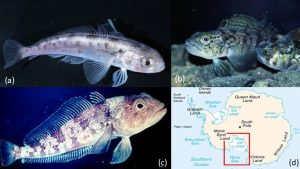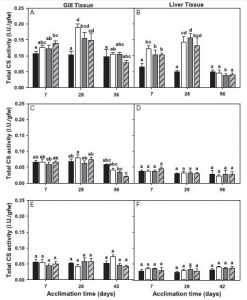The effects of elevated temperature and ocean acidification on the metabolic pathways of notothenioid fish
By Abby Tinari, SRC intern
Notothenioid fish are typically found in the deep, cold waters of the Southern Ocean. Three species of fish native to the Ross Sea were studied to see how they may react to warmer and more acidic oceans.

(a) Pagothenia borchgrevunki (http://adam.antarcticanz.govt.nz), (b) Trematomus newnesi (http://adam.antarcticanz.govt.nz), (c) Trematomus bernacchii (Wikimedia Commons), (d) Ross Sea Location (Wikimedia Commons)
Methods
To measure the effects of temperature on the fish, individuals were randomly selected and placed in one of the four experimental treatment tanks. The experimental tanks consisted of a control treatment, a low temperature and high pCO2, high temperature and low pCO2, and high temperature and high pCO2 to test the individual and overall effects of temperature and pCO2 on the three-fish species. pCO2 is the partial pressure of carbon dioxide in the water. Each fish had an acclimation period that lasted anywhere from 7 to 56 days. Measurements of fish condition and growth were recorded over the course of the experiment. A few tests were performed to analyze enzymatic changes in the liver, white muscle tissue, and gills. One of the tests, the citrate synthase activity test measured how well the fish can release stored energy.
Results
T. bernacchii, the emerald codfish, was the only fish to display any significant impact from the treatments. The growth and condition declined significantly due to temperature but slowed as the acclimation period increased. The group of fish with the faster acclimation period had the largest decline of condition and growth, especially those that also had the multi-stress (high temperature and high <em>p</em>CO2) treatment. The temperature also influenced the Emerald Codfish’s oxygen consumption and metabolic rate. The high <em>p</em>CO2 tank had a small increase in metabolic rate. There were significant increases in citrate synthase activity, the first of which occurred after 7 days in the multi-stress treatment in the gills. By the 28-day acclimation, all treatments had significantly increased in both the liver and the gills.
The bald notothen, P. borchgrevinki, metabolic rates were significantly affected by temperature in the shorter acclimation periods. Interestingly, the oxygen consumption rates decreased in the high temperature treatments over time. Time and temperature were the main drivers in the citrate synthase activity increase in the gill tissues.
Metabolic rates in T. newnesi differed significantly between the acclimation groups with temperature as the main effect. No significant difference between pCO2 and temperature was present. There was however, an increased oxygen consumption rate after the 7 and 28-day acclimation period. The T. newnesi showed the least sensitivity to the treatments. The changes in Citrate synthase activity were not statistically significant.

Citrate synthase enzyme activity (±SE) of Trematomus bernacchii gill (A) and liver tissues (B), Pagothenia borchgrevinki gill (C) and liver tissues (D) and Trematomus newnesi gill (E) and liver tissues (F) acclimated at 7, 28 and 42 or 56 days to a control treatment (low temperature + low pCO2; black bars), low temperature + high pCO2 (white bars), high temperature + low pCO2 (dark gray bars) and high temperature + high pCO2 (light gray bars with cross hatches). Groups not connected by the same letter are significantly different from each other. (Enzor et al. 2017)
Discussion
This group of fish, the Notothenioid fish are critical to the Ross Sea food web. The three-species studied are consumed by seals, penguins, and other top predators. Studies like this one help to predict population responses for not only the Notothenioidei suborder but also other species which depend on these individuals for food.
Temperature had a greater adverse effect on the energy demands for two of the studied species. The fish may be able to acclimate to the higher temperatures, but only to an extent. Higher temperatures may mean a decreased ability to efficiently ingest food leading to decreased growth and other detrimental effects as seen in the Emerald codfish.
It should be noted that the long-term implications of the temperature and pCO2 on growth should be cautiously interpreted due to the small sample size and lack of growth even in the control samples.
References
Enzor LA, Hunter EM, Place SP (2017) The effects of elevated temperature and ocean acidification on the metabolic pathways of notothenioid fish. Conserv Physiol 5(1): cox019; oi:10.1093/conphys/cox019




Leave a Reply
Want to join the discussion?Feel free to contribute!